Oliver & Company: 20th Anniversary Edition
by Ben | February 12, 2009 5:00 pm
Walt Disney Pictures (November 18 1988), Walt Disney Home Entertainment (February 3 2009), single disc, 74 mins plus supplements, 1.66:1 anamorphic widescreen, Dolby Digital 5.1 Surround, Rated G, Retail: $29.99
Storyboard:
Charles Dickens’ classic story of little orphaned Oliver is given a delightfully contemporary Disney twist, swapping the action from ye olde Victorian London town and planting it firmly in the bustling, hyper-hip streets of New York City!
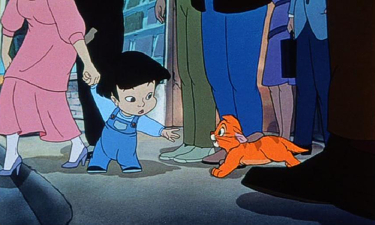
The Sweatbox Review:
I can still very vividly remember the first screening that I saw of the Disney Studio’s 27th animated feature Oliver & Company, taken in at the same theater that I’d seen each feature since The Rescuers onwards. While some of the other films remain slightly foggy memories, Oliver & Company stuck: there was something new and different going on here that pointed out a new direction for where the company’s animation was headed. Previous films had retained the warm and traditional feel of the movies that followed Walt’s death in 1966 and even The Fox And The Hound, despite some rather strong emotional moments, felt very much at home with the likes of Bambi and The Jungle Book.
In 1985, The Black Cauldron attempted to announce a new kind of Disney, but the picture almost sank under the weight of its own ambitions: expecting a kiddie adventure, the word of mouth quickly started turning people (mainly parents) away once they heard about the raising of a dead army of skeletons, the rather drab hero and the sucking of life out of the villain come the film’s climax. Faith was quickly restored thanks to The Great Mouse Detective just one year later, a brilliantly conceived (from Eve Titus’ much more intriguingly named Basil Of Baker Street book) little movie that returned to what Disney did best, but did it quick and economically, keeping the animation division off the chopping block for a little longer at least.

Asserting his position as head of the Studio, then new head Jeffrey Katzenberg picked the story of Oliver Twist as the unit’s next film, but this being the 1980s period when Disney was turning its fortunes around by hiring in some of the biggest names in entertainment and enjoying enormous success as a result, the onus here was to be on a contemporary telling that could accommodate some of the talent the Studio already had deals with. It was seemingly a knock-on effect that essentially washed the floors of Disney Animation clean: although Mouse Detective had been enough of a hit, it had still been the kind of entertainment – a “Disney picture” – that one would usually associate with the Studio. With Oliver the goal was to open up the audience awareness factor by expanding an animated film’s appeal, pulling in new audiences and making the kind of money that live-action, and Disney’s own animated hits of the past, could make.
Steven Spielberg and Don Bluth’s An American Tail had proven that animation wasn’t just for kids, a popularly conceived notion that the medium had been all to happy to accept and become stuck in a rut. That film had outperformed Disney’s offerings in several markets, the slightly more mature story and enormous success and appeal of Linda Ronstadt and James Ingram’s smash hit Somewhere Out There going as far as to bring in their fans to see the film the song was associated with. It wasn’t the first time a song had been one reason audiences kept coming, but it was a wake-up call to the animation world that a liftable ballad from a film’s score could not only win acclaim apart from the film but help promote it at the same time.
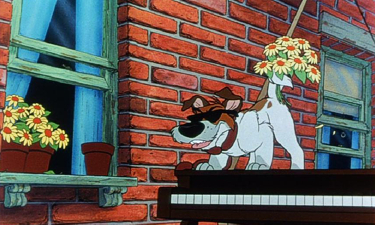
Thus Katzenberg lined up a still impressive number of musical talents whose differing styles would pull in a varied audience as well as sonically illustrate the melting pot sensibilities of New York City. So we have the power balladeering of man of the moment Huey Lewis, the slick studio produced pop of Billy Joel, the Latina influence of Reubén Blades, Ruth Pointer injecting a healthy dose of urban soul and Bette Midler making a big splash for Manhattan’s famous Broadway with a show-stopping turn of epic proportions. Behind the songs the composers weren’t too shabby either: the Lewis’ performed opening Once Upon A Time In New York City not only raises the curtain very cleverly but was also none other than lyricist Howard Ashman’s introduction to the Disney Company.
Ashman had been a huge Disney fan all his life, and the musical version of Little Shop Of Horrors had propelled himself and his writing partner Alan Menken to the forefront of up and coming New York composers to watch. His participation in Oliver & Company’s opening so can’t be underestimated: the lyrics show the kind of simple but vastly effective wordplay that Ashman would complement Menken’s music with in such following films as The Little Mermaid, Beauty And The Beast and Aladdin, the Broadway infused blockbusters whose success was very much down to Ashman’s storytelling songs. And that whole attitude begins at the start of Oliver & Company: where else will you hear the words “Once Upon A Time” set to contemporary music, evoking both a classic storybook feel and clearly providing an up-to-date setting in one hit.
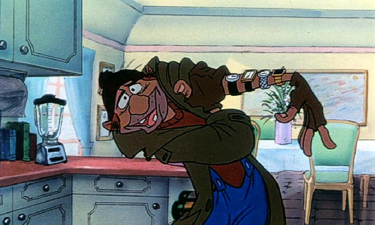
Likewise, many of the artists brought their record producers along with them: Stewart Levine, Phil Ramone, Tom Snow and Willie Colon each get credit, while Midler’s big production ensemble piece Perfect Isn’t Easy was the benefit of a Studio in love with their star (the recently revamped Disney placed an fading Midler in such crude but funny comedies as Down And Out In Beverley Hills, Outrageous Fortune and Ruthless People and watched the profits come rolling in) and open to indulging every whim. Midler’s choice for co-writer and producer on the song was her old touring show composer, a singer-songwriter you may have heard of named Barry Manilow.
Trying to make sense of all this was score composer J.A.C. Redford, most often found in movie credits as an orchestrator (indeed, as on many of Menken’s scores) but a fine writer in his own right and who here manages not only to pull the various styles and musical attitudes together but makes everything sound like it’s coming from the same place. A highly subtle but pinpoint sharp example of this is the film’s very opening moments: on the soundtrack album Once Upon A Time In New York City is very much a pop ballad; in the film, accompanied by Redford’s light strings, it’s part of a wider-encompassing, legitimate score. Just listen to the Bedtime Stories scene and notice how he weaves Dodger’s saxophone into the score, or sit around for the end credit suite and marvel at how he brings all the themes together orchestrally, in a different arrangement to what featured on the soundtrack album.
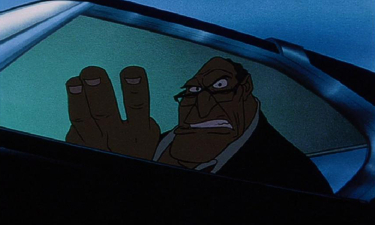
By now, you’ll be able to tell that I’m more than a bit of a fan of Oliver & Company, and it’s not just because of the music. Back at that first screening I was also struck by the visuals, in particular a scene that until that point could have only have been achieved in live-action, unless painstakingly drawn out by an artist working on that one shot for as long as the film was in production. And it still wouldn’t have looked as good. I’m speaking of course, for anyone who has seen the film, about that moment when the grand villain of the piece, the infamous gangster Sykes, is revealed, the camera gliding up from the beaming headlights of his automobile, over the hood and around the side, trucking up to the window as it slowly begins to draw down…man that was amazing stuff to see, not only being vastly impressive technically, but a terrific judgment on the part of director George Scribner on where to really use his limited early computer animation shots for maximum benefit.

Well, we call it CGI today, but back then in the days of Tron and The Great Mouse Detective’s climactic Big Ben mechanism scene, much of this computer trickery had to be printed out in wireframes, traced onto cels, and ink and painted along with the characters. At least the process meant that the computer could work out the shots, angles and line work, and though the simpler geometric shapes sometimes stand out to audiences who are now more familiar with purely CGI’d softness, there’s an impressive amount of computer rendering going on in Oliver & Company that far surpasses the exciting workings of Big Ben in Mouse Detective and makes an extraordinary amount of detailed work – the New York subway chase, Midler’s character’s stairway descent in Perfect Isn’t Easy, not to mention various props and backgrounds – possible. When I saw that reveal of Sykes, it was that moment that defined the new Disney for me, the combination of technology being used to forward the storytelling an ultimate buzz that remained the talking point between myself and the friend I saw the film with long after the movie was gone from theaters.
When it finally hit VHS – and the time between theatrical releases and tape was extraordinarily long thanks to a reissue in 1996 – I wanted to fast-forward straight to that scene, eager to see if it held up on screen as it did in my mind. But as I kept stopping the tape to see how far I’d got, I began to catch other moments in the film that are just as impressive for other reasons. The storytelling is very tight, as one might expect having borrowed the source from an old master, but Disney’s tweaks, subtractions and additions really do go a long way to delivering the same basic plot while navigating around several, it has to be said, rather convoluted twists from Dickens’ original (and tells it in half the time Carol Reed’s famed 1968 movie version does).

The characters are great: Oliver himself is now an orphaned kitty, lost on the dangerous streets of Manhattan until he befriends streetwise mongrel Dodger and joins a gang of down and out dogs of various breeds and temperaments who hang out with human pickpocket Fagin. As per tradition, Fagin finds himself under the dastardly thumb of the villainous Sykes, now a fearsome loan shark with a ruthless pair of Dobermans at his disposal. With money owed to Sykes within days, Fagin’s canine chums take it upon themselves to attempt to liberate a fancy limousine’s car stereo system in order to have something to pawn: a scheme that turns sour when Oliver is mistakenly left behind. Taken in by the delightful young girl Jenny, Oliver is soon used to the high life, much to the dismay of Jenny’s over-pampered pooch, pedigree poodle Georgette (the exuberant Midler). Wanting Oliver out of the house, Georgette is pleased when Dodger and pals spring the cat…leading to Fagin spotting Oliver’s new golden collar. Receiving a ransom note for the return of her pet, Jenny sets out to track down Fagin, but when Sykes turns up for his money, a kidnapped cat is not what he had in mind and he sets his sights to catching Jenny for ransom instead…
Oliver & Company is certainly a product of its times, 1980s filmmaking being full of violent, edgy and sometimes quite stark pieces on screen. Of course Oliver isn’t truly scary, but this is Disney doing something contemporary on a scale like they’ve never achieved before, and as such it does hold up today. There’s still the quality storytelling and animation going on, but there’s also an unmistakable new approach, that this is modern and realistically believable, albeit within the confines of an animated movie. But it never feels glib: the various characters never feeling like poorly written stereotypes or being asked to provide an empty cool factor instead of good character development. Part of this is down to the voices being the characters they are, part of it is simply down to a good script.
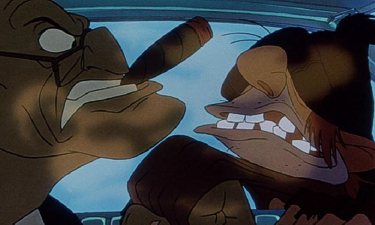
As Fagin, Dom DeLuise has more to play with than with some of the other animated characters he’s lent his voice to and is his best performance since Jeremy in The Secret Of NIMH. Shedding his portly real life appearance, DeLuise’s Fagin is a starved scruff, barely there in form or nature: he hates the situation he’s in, but makes the best of it, warming to his animal companions as the only friends he has, but knowing it’s going to be a tough slog to try and pull himself out of the ongoing circle of low life he’s gotten himself into. A stark contrast is Sykes, voiced with intimidating menace by Robert Loggia, surely the most genuinely scary Disney villain in years (and of the hefty bulk that typifies Glen Keane’s designs). That’s he’s not full of magic, a hint of humor or the benefit of a comedy sidekick really helps keep the character focused: this is a frightening, real-world guy who keeps two very vicious and dangerous dogs by his side. We all probably know of someone like this, an overbearing thug who’s never quite as welcome or as classy as he likes to think he is, and as such that’s why he works so well. Some criticisms were aimed at the film at the time of release for just how real Sykes came over (one might argue he’s a live-action villain in an animated film that sometimes plays more along the Touchstone sensibilities of the time), but surely that’s another sign of good portrayal and strong performances from the artist and vocalist? Whatever, Sykes is as fear-provoking as he needs to be in staying true to Dickens, making his ultimate end – arguably Disney’s only onscreen death and the strongest pay off until Tarzan’s Clayton a decade later – all the more delicious.

The slightly rough and real nature extends to the artwork too: Oliver & Company marks an intentional return to the Xerox process inaugurated with One Hundred And One Dalmatians but here, rather than a shortcut or statement in style, it’s actual production design. It’s not always successful: some of the rougher lines sometimes look as if they’re over egging the process and it doesn’t help those yellow cabs from feeling somewhat out of place, but there’s the definite funky vibe one gets from the hot, sweaty big city and added touches such as the actual product labels for Coca-Cola, USA Today, Kodak and other trademarks play no small part in creating an atmosphere that we can relate to and, therefore, follow the characters through with an added level of acceptance. Also adding perspective – literally – is the aforementioned computer animation, which allows director Scribner to set up some unique angles for an animated film, and kudos to Disney for not retro-erasing the often glimpsed World Trade Center towers from the skyline shots
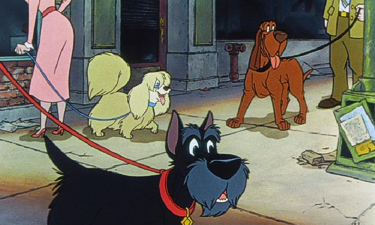
Not to say Oliver isn’t a whole heap of fun: Joel’s signature moment Why Should I Worry? (a song that really should have found success as a single and foreshadows Phil Collins’ similar You Can’t Hurry Love) finds some familiar faces from Disney’s doggie past peppered among the crowds, a nod and a wink anachronism that simply works due to the energy of this particular musical number, and Joel’s performance – he’s none too bad in the speaking role either! As Oliver, a young Joey Lawrence brings a real youngster’s perspective to the part (he was twelve at the time) and Midler of course shines in perhaps the film’s oddest moment, Perfect Isn’t Easy? Odd? Well, while the rest of the film plays with the sounds of the city, Georgette’s number is old-school Broadway – a major piece of the New York puzzle to be sure – but one that might be overindulged here. I’m never too sure of this sequence: it’s certainly a good show-stopping song, but Georgette is a secondary character who seems to have been given a big moment only because of who is voicing her. I like Perfect Isn’t Easy, but it’s also the one moment when the story stops to allow for a song: it’s a lot of screen time given to setting up a character that then plays a minor role, but Midler belts it out in such grand fashion that one can forgive the weakness.
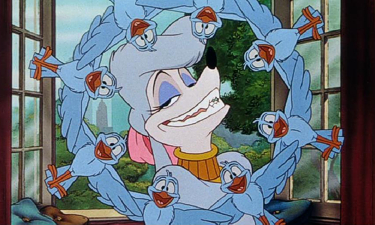
If the New Disney practically came into effect during The Rescuers, The Fox And The Hound the hybrid that attempted to show what they could do, The Black Cauldron the spectacular folly that taught them where their strengths lay and The Great Mouse Detective the film that brought them together for better things ahead, then Oliver & Company is where the elements really gelled and suggested the true new path Disney Animation was about to take. Mouse Detective had washed away the rather stagnant taste of the downbeat Fox And The Hound and Black Cauldron, but for all its showing the new crowd could pull off something as effectively as the old, it’s still a film very much steeped in the Disney ethos of old. For my money, in a great new way it all begins with Oliver & Company, the film that restored truly memorable songs to the Studio’s animated films while forging ahead with fresh sensibilities and returning to the pursuit of technology, in this case the computer, and how it could make their films more believable, just as the Multiplane Camera had done in decades gone by.
The $53 million Oliver & Company grossed in 1988 may sound like small fry now, but it was the first animated film to cross the $50m mark, paving the way for the $89m grossing The Little Mermaid and the renaissance of the 1990s blockbusters. Continuing the run of fresh Disney hits started by The Great Mouse Detective, it’s a shame that the film nowadays gets lost between Basil and Ariel’s adventures, the old-style look somewhat out of place in the middle of those two warmly colored and inked films. Oliver should be celebrated more than it is for daring to be something totally new while striving to retain the qualities that put Disney Animation on the top of the game. It’s not quite the Dickens story as we remember it, but then neither did The Jungle Book resemble Kipling that closely! Charming, exciting, amusing and a terrific thrill ride, Oliver provides perfect company.
Is This Thing Loaded?
After waiting years for a VHS, Oliver & Company came to tape soon after its 1996 theatrical reissue, also appearing on LaserDisc at the same time and allowing for a frame-by-frame analysis of that Sykes car shot and his eventual comeuppance on the Brooklyn Bridge subway tracks…ouch! Seemingly seen as a secondary title in their catalog of animated features, the film was scheduled as part of the Gold Collection series of DVDs before that too was delayed, eventually appearing as a blandly monikered Special Edition with barely a handful of bonus features. Now celebrating its 20th Anniversary (although being released in its 21st year!), the Studio has finally decreed that Oliver & Company is a classic worthy of a revisit on DVD. But is this revisit itself worthy? Read on!
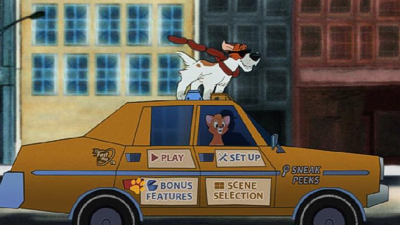
A FastPlay disc, it naturally begins with the usual heap of Sneak Peeks and here we’re previewed Pinocchio: Platinum Edition, the first full trailer for Pixar’s Up (leaning heavily, as always, on all their previous releases), Space Buddies, a shameless modern retro-plug for the original Air Bud (my how the kids will be disappointed when they realise he doesn’t talk via CGI as its hinted at here), an awfully odd teaser for the Beverly Hills Chihuahua disc release, and the Disney Movie Rewards program. From their own option, trails for Bolt, TinkerBell And The Lost Treasure, Tigger & Pooh And A Musical Too, Monsters Inc on Blu-ray, and Imagination Movers are added.
Now separated out into Disney’s regular supplement sections, our first stop for the bonus features is Music & More for a pair of Sing-Along Songs: Why Should I Worry? and Streets Of Gold. Although these selections appeared on the Gold disc, these aren’t carry-overs, instead being the respective sequences from the main feature played out with the subtitle track displaying the lyrics onscreen.
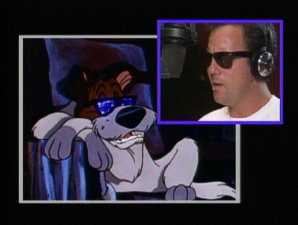
Also from the previous disc, but all the more welcome for having been included again, is The Making Of Oliver & Company, a 5:30 minute featurette from the 1988 theatrical release. This comes from a period in the middle of old-school documentary program making and the whizz-cut soundbite fluff pieces of today, back when interviews were allowed to run for more than just a sentence but with a few video effects thrown in. Even at the (welcome) slower pace, there’s some good info, from concerns over Billy Joel’s ability to act (and he’s seen doing so wearing his shades in the recording studio) to the then all-new computer animation capabilities (described here as “the tip of the iceberg” by Roy Disney, though another quote suggest we shouldn’t look “for computers to replace human animators at Disney”).
From the 1996 theatrical reissue, Disney’s Animated Animals is evidently more recent due to clips including footage from The Lion King, but is an otherwise fairly simple 1:30 video spot that runs through the cast in a bid to introduce them to new audiences, while the Oliver & Company Scrapbook presents 57 images over 14 pages, from development art including a few images from a deleted “Jungle Song” sequence, storyboards, design and model sheets (including some characters cut from the film, production stills and preliminary and final publicity posters. It’s almost just a token offering, but it’s always great to see such art, though I wish there was more on that Jungle Song, which isn’t placed in any context and sounds intriguing!
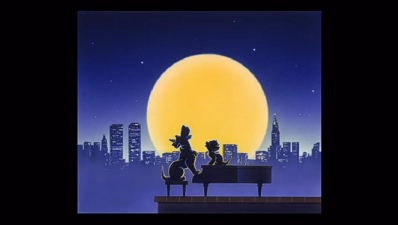
We’ve more Publicity Materials in the form of an all-too rarely seen option on Disney DVDs of late: a full selection of Theatrical Trailers, from the original 1988 release, a 1989 TV Spot, the 1996 reissue and the 1996 television promo The Return Of A Classic, which run a total of five and a half minutes all played. Coming across the original 1988 trailer really did bring back warm memories for me: I distinctly remember seeing it played in the theater and running it endlessly on VHS, and it still stirs up the same kind of excitement that I had in wanting to see the film. The reissue promo quite rightfully addresses the fact that Oliver became the first animated film to really go out and do live-action sized box-office numbers in its initial run, and its pretty cool to hear that confirmed on an official release. Fun Film Facts offers up some more info: nine pages of text on the making of the film, pulled from the previous release but redressed here, adding some decent background to the disc.
A pair of Bonus Shorts have also been included, though I am as perplexed by their inclusion as before. Whatever else, I supposed they add good value to the disc and won’t have new buyers feeling they’re missing out on content from the previous release. They’re not the most original of selections however, and probably only picked because Pluto has a run-in with a couple of kittens in them, particularly the first, the often seen and over-recycled Lend A Paw. This is itself a remake of the black and white short Mickey’s Pal Pluto, though it did win an Oscar for Pluto in 1941 and marked one of the few occasions when Pluto’s good and bad consciences got together to fight over what the pup should do (in this case to save or let a poor little kitty drown). Next is Puss Café, another Pluto cartoon in which he faces off opposite Melvin and Milton, a pair of goofy Siamese cats that caused multiple disruptions in Disney cartoons long before Si and Am came to plague Lady’s life in Lady And The Tramp. Here, the dopey pair try to take their pick of Pluto’s backyard delights. Together the cartoons play for over 15 minutes screen time, amusingly in fairly ropey, pre-restored grunginess as from the previous edition.
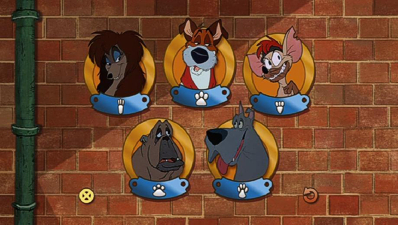
The big new extra for this release, and as usual with all of these recent Disney reissues, is a brand new game, Oliver’s Big City Challenge, found in Games & Activities. In fairness, this isn’t too bad, though the opening instructions are as complicated as they are long-winded! Basically put, one must help Oliver select the right “barking buddy” for the job at hand, be it swiping sausages from the hot dog stand, or rescuing Jenny from Sykes. There’s obviously been quite a lot of work been put into this game, but the need to choose a dog to “help” you through a task is an added obligation that has no bearing on things and also requires that you’ve seen the film to pick up on the clues. Nevertheless, it’s not anywhere near as fruitless or frustrating as other similar such fare, and though it doesn’t lead to any rewards, the re-use of clips and artwork is nicely done.
While it unfortunately seems Oliver & Company has ended up in the secondary pile of Disney classics, after 20 years it has proven to stand the test of time and is still remarkably contemporary in its approach. I seem to recall Billy Joel and Bette Midler attending the opening ceremony at Disneyland Paris (then EuroDisney) and singing their respective songs live on stage, and this footage may have provided a nice bit of context for viewers to see Dodger and Georgette’s real-life counterparts belting out those great tunes, but the only other thing that feels missing here is perhaps a commentary track with director Scribner and a couple of his lead animators (take your pick from the cream of Disney’s current star artists), all of whom still work for the Studio, Scribner now an animation advisor to the theme park Inmagineering division. But the film has been rewarded with a limited though fairly decent listing of supplements which, even if most of them aren’t new to DVD, are welcome and essential nonetheless.
Case Study:
One of the better – actually the best – things about the recent rash of Disney repackages is the new artwork that adorns these releases, and Oliver is treated to perhaps the best so far! An absolutely superb rendering of the characters, headed up naturally by Oliver and Dodger, adorns the front cover, although it’s a little odd in its choice of those characters: missing most noticeably are Fagin, Jenny, Georgette and, forgoing the chance to bring some shadowy peril to the sleeve, Sykes. Are they on the back? Um, nope: We get repeats of Rita and bulldog Francis, joined by Great Dane Einstein and a lot of wasted space taken up by…a rubber lifesaver!? Still, it’s probably preferable to the Gold art, which was as basic as they come.
Instead of the full color disc art from before, this new edition goes with Disney’s matte grey finish, which only just about shows the logo off, itself sporting the nondescript “Walt Disney” banner that neither says if this is a film made under Walt’s eye or the later Feature Animation crew. This worrying new trend appears to simply be slapping the “Walt Disney” name on anything, cheapening it into the bargain. Missing from the Gold edition is a nice chunky insert listing the chapters one side and the special features on the other: here we just get an Oliver/Space Buddies promotion and the benefits of Blu-ray booklet. A glossily embossed slipcase comes with initial printings, making that cover art pop a little more and nicely keeping with tradition it covers a Disney-white keepcase underneath.
Ink And Paint:

If there’s anywhere that gives away Oliver & Company’s age, it’s in the grainy film stock used at the time. Unfortunately the film doesn’t look like it’s ever going to receive the kind of clean-up job that the similar The Little Mermaid did for its Platinum Edition, but I’m at a loss as for why it doesn’t look quite as good as its other companion of a comparative period, The Great Mouse Detective. Surely there’s a less weaving negative in the vaults that could be used for a better presentation or slight passing of grain removal? This isn’t the best a Disney animated feature has ever looked and, as a film last released as recently as 1996, I can’t make out why. It doesn’t look bad, but certainly not up to the digital presentations of today or even the restorations of old films; come the eventual Blu-ray edition, we’re going to be disappointed if this is what comes to HD and one would hope the reason it hasn’t been release simultaneously is because a more extensive transfer is on the cards.
Making a direct comparison between the Special Edition and this 20th Anniversary release, it’s clear the same print has been commandeered and I wouldn’t be surprised if they were one and the same transfer. But there’s a hint of a minor pass of a remaster attempt at removing some of the print debris and the gate weave could be a little less distracting, though it’s still there. Certainly the compression seems less cramped: the previous disc’s content added up to 5.79gb of capacity while this one totals 7.26gb, either storage space spent on upping the bits or adding the new game. Those with the Special Edition disc shouldn’t worry about an upgrade, however: the differences are barely noticeable and only the result of much scrutinising here.
Scratch Tracks:
I will say that for all of Oliver’s visual fuzziness, the soundtrack is a pulsating experience. The film was mixed at a time when Dolby was still relatively new and sound designers were pushing audio effects to the fore. Some of the tracks from around this time can sound quite piercing to audiences nowadays, but this 5.1 configuration from the 1996 reissue sounds as good as animated films come. It’s the same track as from the previous edition, though it sounds a little quieter overall, which when one adds a notch or two to the volume actually reveals more of a dynamic track. Again, there are no great shakes between this and the Special Edition release: fans with either disc should feel they’re getting the best out of what Oliver & Company has to offer. English, French and Spanish 5.1 dubs and subs are all optional, the foreign subtitles new to this edition.
Final Cut:
While the addition of a new game usually means the dropping of other, better content from previous editions, Oliver & Company benefits from not having any of its Special Edition features missing. Technically, one could mention the switching of the original Sing-Alongs from the specially created “Disney Songbook” versions (with the bouncing Mickey head) for the straight sequence lifts from the feature and lyric subtitle track engaged that appear here, but that’s nitpicking and the bare essential same material is to hand. Basically those with the Special Edition are missing nothing but the new but non-essential game, and those discovering the title for the first time should feel satisfied that they pretty much have everything carried over from the last disc. Spectacularly entertaining, packed with great touches, toe-tapping songs and a superbly thrilling climax, it’s good to see Oliver & Company getting some recognition. Does it deserve it? Absotively posalutely!
 | ||
 [1] [1] |
- [Image]: http://www.amazon.com/exec/obidos/ASIN/%20B001ILFUD2/animatedviews-20
Source URL: https://animatedviews.com/2009/oliver-company-20th-anniversary-edition/